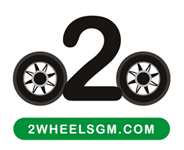Having good control of your motorbike, scooter or moped is vital at all times - but never more so than when cornering.
Corners create one of the most common crash scenarios for bikes, and inevitably the reasons for crashes are simple: bad positioning, too much speed and poor or non-existent observation by the rider.
Want to stay safe when tackling corners on two wheels? Then remember your three Ps: Preparation, Paths and Posture.
Prepare: when approaching a corner look ahead for visual clues as to any potential hazards ahead, particularly if it is a long bend and you cannot see your exit. Try to look five seconds ahead to plot your route.
Advisory speed signs and double white lines on the road are clues that tell you it is a tight bend that demands rider caution. It's also important to be aware of the road camber: which way does it go – to your left or right? A sharp camber on a bend can upset even the most experienced rider's balance.
You must also watch your speed. Many bikers get themselves in trouble cornering by entering the bend too quickly, causing them to lose control at a time when full control is even more crucial than normal. Getting halfway through the bend and realising you are going too fast is a recipe for disaster so be cautious: enter at a lower speed than you think necessary and look to accelerate out of the bend.
Path: It's important your path into the bend is right. If it is safe to do so, try to position yourself where you have the widest possible view of the road ahead; it will give you vital warning of any hazards.
Think also about where you want the bike to be in the middle of the bend, and where you will exit the corner. At the middle of the bend you want to avoid being too wide. If someone coming the opposite way is cutting the corner, where will that leave you? You might start wide but by the middle of the bend you need to be in the middle of your lane for safety.
To exit stay tight to the inside of your lane.
Posture: Throughout the manoeuvre watch your posture. There’s an old saying: tense below the hips, relaxed above. It might sound like the instructions to a fitness session but it actually gives you good clues as to how to sit on your bike. Legs, particularly thighs and knees, need to stay tense and taut while riding to give you a stable base. Above the hips, keep it loose, with a nice and relaxed shoulders and back. Your head should be up, eyes level with the horizon to maintain balance. To check your instruments, mirrors and the road don't tilt your head - scan down with your eyes.
When cornering sit upright but look ahead by pointing your eyes and chin into the bend and drop your shoulder to lean gently into the corner. If you are taking the corner at a very slow speed (below 10mph), remember to lean your bike in, body out slightly to counteract the pull of gravity, which is more pronounced at slower speeds.
You'll need slow, positive acceleration and slight pressure on the rear brake to increase ride stability.
If you need to brake, do it gently and progressively. Apply pressure on the brake levers with your fingertips for better feel. Avoid sharp braking at all costs: it can lead to the tyres locking-up, sending you into a potentially disastrous skid.
Understanding how to corner safely is a crucial part of being a good rider. Follow these simple tips and you'll come out of bends smiling.
